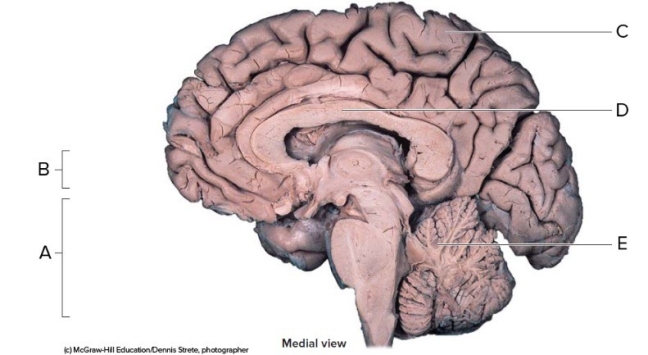A) The brainstem consists of the medulla, pons, and cerebellum.
B) The brainstem is responsible for higher level thinking skills.
C) Damage to the brainstem is usually fatal.
D) All twelve cranial nerves enter or exit from the brainstem.
E) The brainstem is a relay for sensory input only.
G) C) and E)
Correct Answer

verified
Correct Answer
verified
Multiple Choice
From which embryonic brain region does the medulla oblongata form?
A) Telencephalon
B) Diencephalon
C) Mesencephalon
D) Metencephalon
E) Myelencephalon
G) A) and B)
Correct Answer

verified
Correct Answer
verified
Multiple Choice
The cerebral aqueduct connects
A) the two lateral ventricles.
B) the third ventricle to the fourth ventricle.
C) the lateral ventricles to the third ventricle.
D) the fourth ventricle to the subarachnoid space.
F) A) and C)
Correct Answer

verified
Correct Answer
verified
Multiple Choice
Thirteen year-old Austin exhibits retarded growth, reduced metabolism, lack of normal reproductive gland development, inability to regulate water intake or water elimination from the body, and an uncontrolled appetite. Which part of Austin's brain is most likely involved?
A) Reticular formation
B) Primary sensory cortex
C) Medulla oblongata
D) Thalamus
E) Hypothalamus
G) B) and D)
Correct Answer

verified
Correct Answer
verified
Multiple Choice
Walking a tightrope would activate which portion(s) of the medulla?
A) The pyramids
B) The superior colliculi
C) The olives
D) The pyramids and the superior colliculi
E) The pyramids and the olives
G) A) and D)
Correct Answer

verified
Correct Answer
verified
Multiple Choice
 -This is a midsagittal section of the right half of the brain. What does "E" represent?
-This is a midsagittal section of the right half of the brain. What does "E" represent?
A) Cerebrum
B) Cerebellum
C) Corpus callosum
D) Diencephalon
E) Brainstem
G) C) and D)
Correct Answer

verified
Correct Answer
verified
Multiple Choice
The inferior colliculi
A) are an integral part of the cerebrum.
B) are involved with auditory pathways in the CNS.
C) interconnect directly with the eye.
D) are a major CNS motor neurotransmitter group.
E) are located in the pons.
G) A) and D)
Correct Answer

verified
Correct Answer
verified
True/False
Abnormal development in the telencephalon may also affect the development of the lateral ventricles.
B) False
Correct Answer

verified
Correct Answer
verified
Multiple Choice
What is the group of structures in the brain that is involved with emotions and memory?
A) Basal nuclei
B) Limbic system
C) Reticular formation
E) All of the above
Correct Answer

verified
Correct Answer
verified
Multiple Choice
Tracts of white matter that connect the right and left hemispheres are composed of ________ fibers.
A) decussation
B) association
C) commissural
D) projection
E) pyramidal
G) A) and B)
Correct Answer

verified
Correct Answer
verified
Multiple Choice
The basal nuclei function to
A) produce stiff, exaggerated movements.
B) assist the autonomic nervous system.
C) inhibit unwanted muscular activity.
D) control alertness.
E) store memory.
G) All of the above
Correct Answer

verified
Correct Answer
verified
Multiple Choice
Motor control of the face is the function of the ________ nerve, while sensation from the face is determined by the ________ nerve.
A) facial; trigeminal
B) trochlear; facial
C) facial; glossopharyngeal
D) trigeminal; glossopharyngeal
E) trigeminal; facial
G) A) and B)
Correct Answer

verified
Correct Answer
verified
Multiple Choice
The nuclei of cranial nerves III, IV, and V are located in the ________.
A) pons
B) medulla oblongata
C) midbrain
D) diencephalon
E) cerebellum
G) D) and E)
Correct Answer

verified
Correct Answer
verified
Multiple Choice
The accessory nerve
A) has fibers that join the vagus nerve.
B) has both a cranial and a spinal component.
C) provides innervation to the trapezius and sternocleidomastoid muscles.
D) is cranial nerve XI.
E) All of the choices are correct.
G) C) and E)
Correct Answer

verified
Correct Answer
verified
Multiple Choice
Which of the following is NOT part of the limbic system?
A) Lateral geniculate nucleus of the thalamus
B) Cingulate gyrus of the cerebral cortex
C) Dentate gyrus of the hippocampus
D) Olfactory cortex
F) All of the above
Correct Answer

verified
Correct Answer
verified
Multiple Choice
Henry has a thrombus just beyond where the vertebral arteries join on the base of the pons. Which vessel is affected?
A) Dural sinuses
B) Basilar artery
C) Cranial artery
D) None of the choices are correct.
F) All of the above
Correct Answer

verified
Correct Answer
verified
Multiple Choice
From which embryonic brain region does the cerebellum form?
A) Telencephalon
B) Diencephalon
C) Mesencephalon
D) Metencephalon
E) Myelencephalon
G) A) and D)
Correct Answer

verified
Correct Answer
verified
Multiple Choice
Injury to the reticular formation can result in which of the following?
A) Irreversible coma
B) Hypertension
C) Parkinson disease
D) Alzheimer disease
F) A) and C)
Correct Answer

verified
Correct Answer
verified
Multiple Choice
A physician is evaluating the cranial nerve function of a patient. To evaluate trigeminal nerve function, the physician should
A) stand behind the patient and whisper words to see if the patient can repeat them.
B) ask the patient to follow the movement of an object with her gaze.
C) ask the patient to open her mouth and stick out her tongue.
D) touch the surface of the patient's eyeball to initiate blinking.
F) A) and C)
Correct Answer

verified
Correct Answer
verified
Multiple Choice
If an animal has had its cerebrum removed, it cannot ________.
A) see
B) live
C) breathe
D) regulate body temperature
E) regulate heart rate
G) A) and C)
Correct Answer

verified
Correct Answer
verified
Showing 141 - 160 of 176
Related Exams